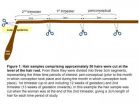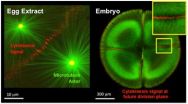Tau, not amyloid-beta, triggers neuronal death process in Alzheimer's
2014-10-31
(Press-News.org) WASHINGTON — New research points to tau, not amyloid-beta (Abeta) plaque, as the seminal event that spurs neuron death in disorders such as Alzheimer's disease. The finding, which dramatically alters the prevailing theory of Alzheimer's development, also explains why some people with plaque build-up in their brains don't have dementia.
The study is published online today in the journal Molecular Neurodegeneration.
Neuronal death happens when tau, found inside neurons, fails to function. Tau's role is to provide a structure — like a train track —inside brain neurons that allows the cells to clear accumulation of unwanted and toxic proteins.
"When tau is abnormal, these proteins, which include Abeta, accumulate inside the neurons," explains the study's senior investigator, Charbel E-H Moussa, MB, PhD, assistant professor of neuroscience at Georgetown University Medical Center. "The cells start to spit the proteins out, as best they can, into the extracellular space so that they cannot exert their toxic effects inside the cell. Because Abeta is 'sticky,' it clumps together into plaque," Moussa says.
He says his study suggests the remaining Abeta inside the neuron (that isn't pushed out) destroys the cells, not the plaques that build up outside. "When tau does not function, the cell cannot remove the garbage, which at that point includes Abeta as well as tangles of nonfunctioning tau, and the cell dies. The Abeta released from the dead neuron then sticks to the plaque that had been forming."
Moussa's experiments in animal models also show less plaques accumulate outside the cell when tau is functioning; when tau was reintroduced into neurons that did not have it, plaques did not grow.
Malfunctioning tau can occur due to errant genes or through aging. As individuals grow older, some tau can malfunction while enough normal tau remains to help clear the garbage. In these cases, the neurons don't die, he says. "That explains the confusing clinical observations of older people who have plaque build-up, but no dementia," Moussa says.
Moussa has long sought a way to force neurons to clean up their garbage. In this study, he shows that nilotinib, a drug approved to treat cancer, can aid in that process. Nilotinib helps the neuron clear garbage, but requires some functional tau, he says.
"This drug can work if there is a higher percentage of good to bad tau in the cell," Moussa says. "There are many diseases of dementia that have malfunctioning tau and no plaque accumulation, such as frontal temporal dementia linked to Parkinsonism," Moussa says. "The common culprit is tau, so a drug that helps tau do its job may help protect against progression of these diseases."
INFORMATION:
Co-authors include researchers from Capital Medical University in Beijing, China, and Merck Research Laboratories.
Funding for these studies was provided by Georgetown University grants and by Merck & Co.
Moussa is an inventor on a Georgetown University patent application for use of nilotinib as a therapeutic approach in neurodegenerative diseases.
About Georgetown University Medical Center
Georgetown University Medical Center (GUMC) is an internationally recognized academic medical center with a three-part mission of research, teaching and patient care (through MedStar Health). GUMC's mission is carried out with a strong emphasis on public service and a dedication to the Catholic, Jesuit principle of cura personalis -- or "care of the whole person." The Medical Center includes the School of Medicine and the School of Nursing & Health Studies, both nationally ranked; Georgetown Lombardi Comprehensive Cancer Center, designated as a comprehensive cancer center by the National Cancer Institute; and the Biomedical Graduate Research Organization, which accounts for the majority of externally funded research at GUMC including a Clinical and Translational Science Award from the National Institutes of Health. END
ELSE PRESS RELEASES FROM THIS DATE:
Resveratrol could reverse benefits of being active
2014-10-31
Contrary to popular belief, use of the supplement resveratrol (RSV) may not actually enhance the effects of high-intensity interval training (HIIT).
Many news outlets and health blogs have long recommended RSV as a complement to exercise and to enhance performance. However, results from a study by Queen's researcher Brendon Gurd suggest that RSV may actually impede the body's response to training.
"The easiest way to experience the benefits of physical activity is to be physically active," says Dr. Gurd, a professor in the School of Kinesiology and Health Studies. "The ...
Immune cells proposed as HIV hideout don't last in primate model
2014-10-31
Where does HIV hide? Antiretroviral drugs can usually control the virus, but can't completely eliminate it. So any strategy to eradicate HIV from the body has to take into account not only the main group of immune cells the virus targets, called CD4 or helper T cells, but other infected cells as well.
New research from Yerkes National Primate Research Center, Emory University, sheds light on the question of which cells support viral replication and persistence, and the answers have implications for future efforts to eliminate HIV from the body in human patients.
The ...
Mussels on California Coast contaminated with giardia transmitted from land-based sources
2014-10-31
The pathogen Giardia duodenalis is present in mussels from freshwater run-off sites and from areas where California Sea Lions lounge along the coast of California, according to a team of researchers from the University of California, Davis. One of the G. duodenalis strains found is known to infect humans; the two others occur mostly in dogs and other canids. "Thus, the detection of these assemblages implies a potential public health risk if consuming fecally contaminated water or uncooked shellfish," says coauthor Woutrina Smith. The research is published ahead of print ...
Avivagen publishes evidence for natural alternative to antibiotic use in livestock
2014-10-31
Today the leading journal PLOS ONE published research that provides underlying scientific support for a fundamentally new type of natural alternative to the use of antibiotics in livestock feeds for growth promotion and disease prevention. The paper is the result of work by both independent and company scientists. Avivagen Inc. is a wellness company developing and delivering products that support and enhance the health and quality of life for animals and the people who care for them.
The discovery that the product formed by full, spontaneous oxidation of beta-carotene, ...
Drug tests on mothers' hair links recreational drug use to birth defects
2014-10-31
Drug tests on 517 mothers in English inner city hospitals found that nearly 15% had taken recreational drugs during pregnancy and that mothers of babies with birth defects of the brain were significantly more likely to have taken drugs than mothers with normal babies. The study found no significant links between recreational drug use and any other type of birth defect.
The study was led by a team of UCL researchers co-ordinating data collection from hospitals across London, Bristol and Birmingham and the results are published in the journal PLOS ONE. The study included ...
Bladderwrack: Tougher than suspected
2014-10-31
It is up to 30 centimetres long, it has a green-brown color and is probably known to every beach walker on the North and Baltic Sea: the bladderwrack, a seaweed, which is common on the coasts of the whole North Atlantic area. The bladderwrack provides food and habitat for many other organisms. Its abundance is considered to be an indication of whether a coastal ecosystem is intact or not. Especially in the German Baltic Sea, however, the populations have declined considerably in the past decade. The reasons for this are not yet fully known. "Against this background, it ...
Fun and games make for better learners
2014-10-31
Four minutes of physical activity can improve behaviour in the classroom for primary school students, according to new research by Brendon Gurd.
A brief, high-intensity interval exercise, or a "FUNterval," for Grade 2 and Grade 4 students reduced off-task behaviours like fidgeting or inattentiveness in the classroom.
"While 20 minutes of daily physical activity (DPA) is required in Ontario primary schools, there is a need for innovative and accessible ways for teachers to meet this requirement," says Dr. Gurd, lead researcher and professor in the School of Kinesiology ...
Scientists seek cure for devastating witches' broom disease of the chocolate tree
2014-10-31
In the early 1900s, Brazil was the world's largest producer of cocoa. Chocolate trees (Theobroma cacao) were cultivated in a 800, 000 ha region of rainforest in the state of Bahia, beneath a dense canopy of native shade trees. Whereas the surrounding rainforest was a biodiversity hotspot, the chocolate trees, which were derived mainly from a handful of seeds introduced in the mid 1700s, had very low levels of genetic variation. According to Brazilian scientist Gonçalo Pereira, "This scenario created a very romantic, but extremely fragile situation". Genetic variation ...
Decoding the emergence of metastatic cancer stem cells
2014-10-31
In the first study of its kind, Rice University researchers have mapped how information flows through the genetic circuits that cause cancer cells to become metastatic. The research reveals a common pattern in the decision-making that allows cancer cells to both migrate and form new tumors. Researchers say the commonality may open the door to new drugs that interfere with the genetic switches that cancer must flip to form both cancer stem cells and circulating tumor cells -- two of the main players in cancer metastasis.
"Cells have genetic circuits that are used to switch ...
Cell division, minus the cells
2014-10-31
The process of cell division is central to life. The last stage, when two daughter cells split from each other, has fascinated scientists since the dawn of cell biology in the Victorian era. For just as long, it has been notoriously difficult to study this final step, when the dividing cell creates a furrow before cleaving in two.
The name given to this process by those early biologists, cytokinesis, translates as "cell movement" and captures the sense of a highly active and organized series of events. Scientists have now learned much more about the proteins involved ...




